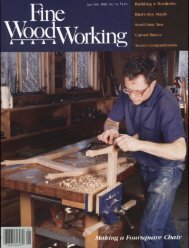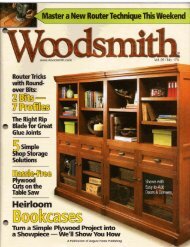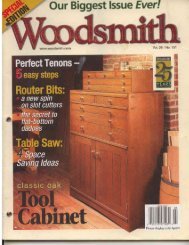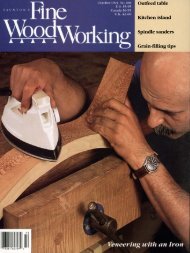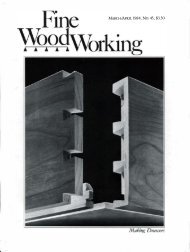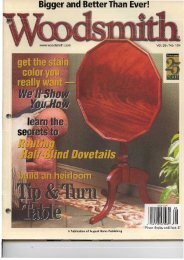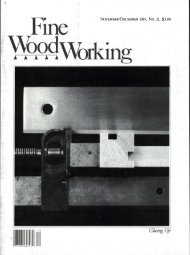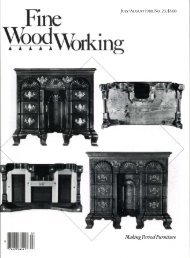orking - MetosExpo - Free
orking - MetosExpo - Free
orking - MetosExpo - Free
Create successful ePaper yourself
Turn your PDF publications into a flip-book with our unique Google optimized e-Paper software.
connecting this point with the edge of the 19-in. mark will<br />
give the angle at which to cut the slides.<br />
To be sure that all the slides will have the same angle and<br />
be cut exactly the same, you should construct a jig. Square a<br />
piece of plywood about 6 in. wide and a foot longer than the<br />
angled portion. Place the slide over the plywood with both<br />
marks (the ends of the line you have drawn) just touching the<br />
bottom edge of the plywood. Then trace the end and the<br />
other side of the slide and bandsaw out the shape.<br />
With the table-saw fence still at the same setting you used<br />
to cut the plywood jig to width, insert the slide into the jig<br />
and make the cut. Use the same setup for all four slides and<br />
you can be sure they will all turn out the same.<br />
The slides run in slots in the end aprons and the parallel<br />
center support. One pair of slides travels inside the other pair,<br />
and the two run side by side in the slots in the center support.<br />
To lay out these grooves, mark lines on top of the apron at<br />
both ends, 1-114 in. from the inside edge of all four legs.<br />
With a long straightedge, transfer these lines to the center<br />
support. Mark the thickness of the slide to the ozttszde of the<br />
table from these lines on one apron, and to the inside of the<br />
table from the lines on the other. On the center support,<br />
mark the thickness of a slide to both sides of the center line.<br />
The grooves on the end aprons must be the same depth as<br />
the slide at that point, so that the leaf will clear the apron as it<br />
is extended. To fi nd this depth, measure in 4 in. from the<br />
tapered end of the slide and cut the groove to the exact depth<br />
of the slide at this point, in this case 7/8 in .<br />
To find the depth of the grooves in the center support, f{rst<br />
mark its location onto the slides, in this case 25 -1/4 in. from<br />
the tapered end, or half of the length of the closed table.<br />
Then push the tapered side down flat and measure the depth<br />
at the marked point, in this case 1-7/8 in. This is the minimum<br />
depth that will allow the leaf to rise 3/4 in. in its travel ;<br />
the grooves may be cut a little deeper if you wish.<br />
Now that all the measurements and cuts have been made,<br />
the tapered ends of the slides can be trimmed. I wanted the<br />
closed slides to extend 1 in. beyond the apron , so I cut off 3 in.<br />
To assem ble the table, place the slides in the grooves with<br />
the angled sides up. Put the leaves in position (don't forget<br />
that you just trimmed 3 in. off the end of each slide) , and<br />
glue and screw the slides to the leaves. To locate the stops, extend<br />
the leaves 19 in. and mark where the slides pass through<br />
the center support. Then screw on the stops at this point.<br />
The central plywood piece is screwed to the base above the<br />
central suppOrt. It prevents the leaves from falling down<br />
when they are pulled out and locates the tabletop. Drill two<br />
3/4-in. holes in the central plywood piece between the slides<br />
and the apron ; these are the guide holes for the top .<br />
Now push the leaves in and locate the top in its correct<br />
position . Clamp it down to the leaves and mark the location<br />
of the guide holes on the underside of the top. Then drill and<br />
gl ue two 3/4-in. dowels into these holes. The dowels should<br />
be about 2 -1/4 in. long, since the top has to move up a full<br />
3/4 in . while the leaves are being extended .<br />
When you push the leaves back in you have to lift the<br />
tabletop. To prevent scratches that would result from the<br />
tabletop sliding on the leaves, I glued two strips of felt to the<br />
bottom of the top . Use hot hide glue or rubber cement.<br />
f----45-5 / 8 in.-----'<br />
1 9 in·-l J<br />
Lay out slide, then transfe r marks<br />
to plywood to make tapering jig .<br />
f----30 in.<br />
----o-i<br />
51,",)<br />
Jig<br />
Blade<br />
Slide<br />
Ripping the taper: Jig guarantees fo ur identical slides.<br />
Push taper flat to measure depth of slot at center support line.<br />
Contributing Editor Tage Frid is professor of woodw<strong>orking</strong><br />
and indltStrial design at Rhode Island School of Design.<br />
Slots fo r slides are cut in aprons, center STtpport.<br />
37



